Liquefied gases, mostly, flammable, toxic and dangerous for human health. This article contains list of the emergency situations, which can happen on the LNG or LPG carrier, and procedures to avoid it.
The Principal Hazards
Flammability and Explosion
All hydrocarbon and chemical based liquefied gases, with the exception of chlorine, ate flammable.
Liquid spills can result in the formation of large vapour clouds that will seek low ground and be slow to disperse in the absence of wind, when the vapours are denser than air. Only methane when warmer than -100 °C, and ammonia when close to ambient temperature, are less dense than air.
1 m3 of LNG = 600 m3 of vapour. 1 m3 of LPG = 250 m3 of vapour.
If vapour finds a source of ignition in a confined space and if there is sufficient air to support combustion, an explosion may result.
Toxicity and Toxic Products of Combustion
Some liquefied gases present toxic hazards if the vapours are breathed in. Toxic gases, such as ammonia and chlorine arc also irritants to the skin and mucous membrane.
Incomplete combustion of a hydrocarbon product may produce carbon monoxide, which is found occasionally in inert gas. Combustion of vinyl chloride may produce the toxic gas, carbonyl chloride.
Loss of Visibility from a Vapour Cloud
When cold liquid is spilled it evaporates rapidly to produce cold vapour clouds. In conditions where the atmosphere is humid this will result in dense white clouds of condensed water vapour being formed.
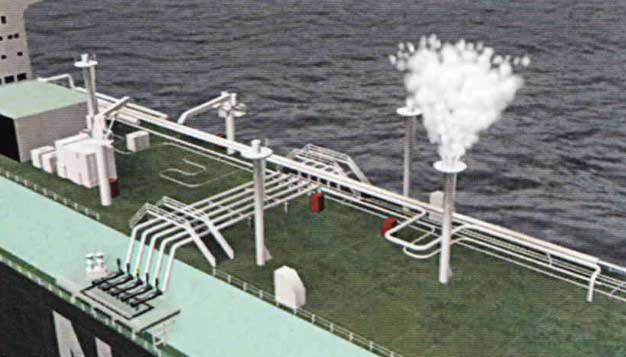
The resulting loss of visibility can present a serious hazard as the cloud may extend beyond the immediate environment of the ship to a jetty or other surrounding area.
Cold Burns
Direct contact with cold liquid or vapour or even un-insulated pipes and equipment may cause cold burns or frostbite that may permanently damage organs such as the lungs. Under certain ambient conditions a thick layer of ice or frost may build up on un-insulated equipment and this may act as insulation.

However, under other conditions, little or no frost will form and in such cases contact can be particularly dangerous. Protective clothing should be worn as necessary and frostbite prevented by avoiding contact with cold cargo liquid, vapour or equipment.
Brittle Fractures
Cold liquefied gas spilled onto the cargo deck or over the side of a ship, which is constructed of mild steel will, through evaporation and thermal cooling, cool down to a temperature that is well below the temperature of the liquid. When large spills are involved this may result in fracture of the ship’s hull or deck.
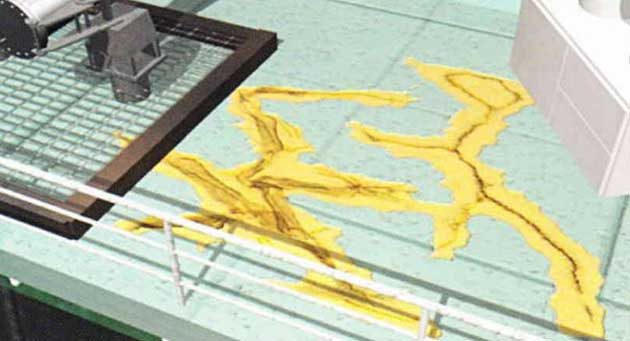
This is particularly hazardous when handling very low temperature liquids such as LNG or ethylene, were wooden or stainless steel drip trays are often provided under the ship’s manifold to drain the cargo away from the ship’s deck and sides.
Fire Protection and Fire Extinguishing
The IGC Code deals with the need for fire protection equipment in gas-dangerous enclosed spaces as such spaces require inerting or fire smothering provisions. Typically, this system is capable of carrying out either function.
If a flammable leak occurred with a concentration of vapours likely to rise above the lower flammable limit, then the fire protection system would be actuated and an atmosphere created within the space that is lacking sufficient O2 to support combustion.
The fixed gas detection system normally alarms at 20 % of the lower flammable limit. A decision will then be made as to whether the leakage is severe enough to actuate the inerting system. One method is to have the early warning detector set at around 20 % and other detectors set at 60 % of the lower flammable limit. When the latter alarms the inerting system is either automatically or manually actuated and, at the same time, the ventilation is stopped.
Inert Gas, CO2 and N2 can all be used to extinguish fires. They all reduce the O2 contents.
If the protection system can inert it can also be used as an extinguishing medium. inert gas, CO2 and N2 will extinguish a fire by smothering, i. e. by reducing the O2 content.
Liquefied Gas Fires
If there is a leak there is a possibility of fire, so it is important to have knowledge of the behaviour of gas fires and how to fight them.
On liquid gas fires the central core temp will be 1 000 – 2 000 °C.
When LNG or LPG escapes, approximately 30 % will rapidly evaporate to form a vapour cloud and the remainder will fall to the deck to form a pool. If the vapour cloud is ignited it will be rapidly consumed and the flame will flash to the pool area, where flames will evolve over the pool.
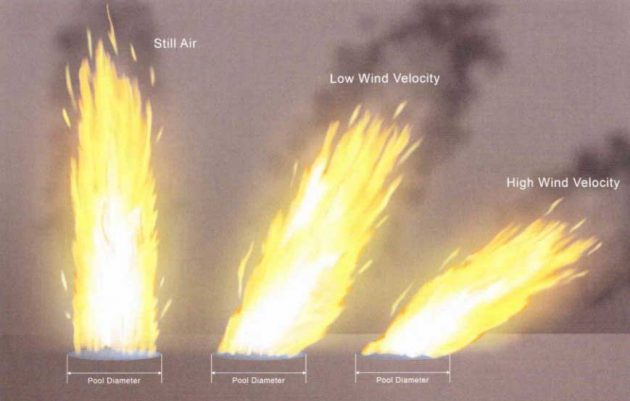
Heat from the flames will be radiated onto the surface of the pool, increasing the rate of vapourisation of the liquid. The vapours then feed the flames and increase the flame height until a maximum height is reached. At this point the pool reaches equilibrium.
Pool fires burn at the rate of 15 mm of pool depth per minute. Water can be used to cool or deflect the fire from a pressure-jet fire.
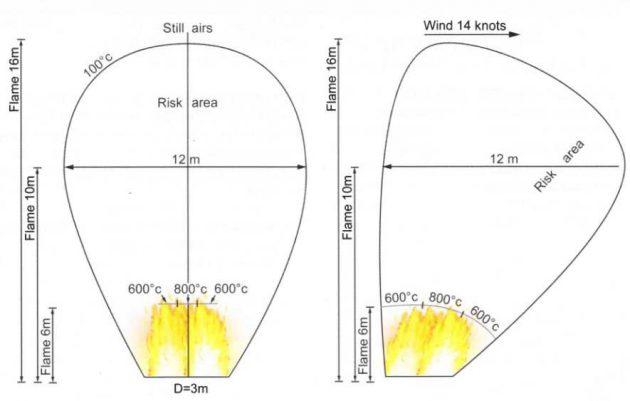
Another type of fire that may be encountered is the pressure-jet type. This is normally directional and has a relatively small influence on surrounding areas, except for equipment within the flame zone.
Liquefied Gas Fire-Fighting
In any fire involving an escape of LNG or LPG, the following practice should be adopted:
- The flame should NOT be extinguished until the source of the leak has been isolated;
- The main efforts of the emergency team should be cooling the equipment that is at risk and within the flame and radiated heat zone;
- Where possible, approach should be made from upwind of the incident area;
- All nozzles attached to the water firehoses should be of the variable spray/jet type. Approach should always be made with the nozzles at their maximum spray positions to protect the operator from radiated heat. When the position nearest to the source of the leak is reached and secured, nozzles can be adjusted to direct cooling water on the fire, with the emphasis on spray rather than jet;
- Water should never be directed at the pool of LNG or LPG as this would increase vapourisatior, causing uncontrolled violent boiling of the liquid pool.
When almost pure, LNG burns without generating smoke.
If the ship is alongside a jetty when a fire incident occurs, it is probable that help will be available from the shore installation fire-fighting facilities.
All gas tankers are fitted with fire protection water sprays over the cargo deck area and on the front of the bridge. This arrangement is designed to protect the cargo and ship’s accommodation from radiated heat in the event of a fire on board. The spray systems are the first line of defence and the water can absorb large quantities of heat, which is its primary objective.
Where there is a leak without a fire, it must be assessed as to whether the deck spray system is activated or not as, if it is, it could cause the rapid generation of vapours when the liquid in the pool picks up heat from the water.
Further protection is available from the fire water hose system.
To prevent salt encrustation and seizing of the nozzle, all nozzles should be left at full spray when not in use.
When the fire hose is in the full spray nozzle setting and the hydrant is opened there will be less kickback experienced than if the nozzle is set on a jet.
Primary targets for the fire hose are any remotely operated cargo shut-off valves. Preventing these valves overheating will give them a greater chance of operating when required, reducing the size of the potential incident.
Nozzles in the spray position can be used to create a shield from the drift of a vapour cloud or to deflect such a cloud.
The final main item of fire protection equipment required by the IGC Code is a dry chemical powder system, capable of extinguishing the fire. The dry powder system can be either a monitor or consist of hand held nozzles that must have a discharge rate of at least 3,5 kg of powder per second. The kickback from a nozzle discharging at this rate will be very severe.
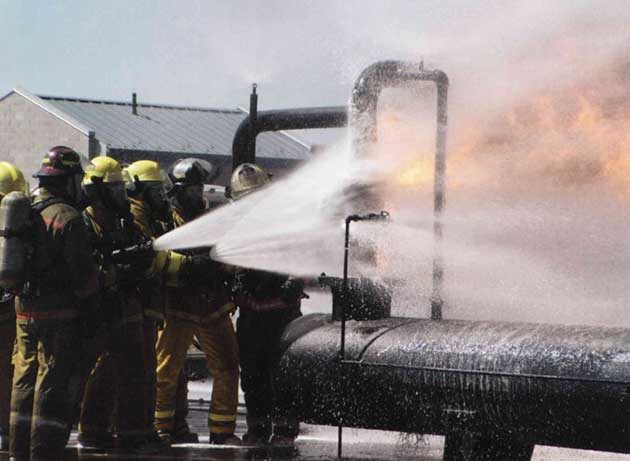
Unless the operator is trained in its use, they can easily lose balance or even lose the hose, which could whip like a pneumatic air hose. The hand-held gun-type applicator requires two people working as a team. Where powder monitors arc mounted on the ship, the design is such that the nozzle recoil is taken up by the monitor mounting.
When attempting to knock out the fire using dry powder; a decision must be made as to whether or not the water spray system is to be cut off before the powder strike.
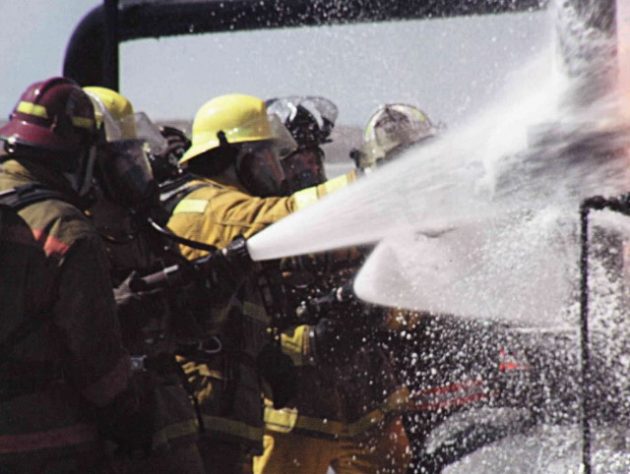
With a fire burning and the water sprays in action, the cooling effect of the water can create dense clouds around the fire, obscuring its seat. Should the water be turned off, the fire may burn out and reveal the seat of the flame, providing a better target at which to aim.
1 Sodium bicarbonate powders
Dry powders, based on sodium bicarbonate, are normally projected at the base of the fire. However, such powders are soluble in water and a proportion of the powder may be eliminated if the powder must pass through a water curtain from the spray.
2 Potassium based powders
Powders based on potassium can be shot through a water curtain to extinguish fire.
When there has been a leak that has caused a pool to form, the vapours arising from it may be flammable, toxic or both. lf there is no fire, the vapours will continue to be generated for as long as the pool remains. Foams with low expansion have too high a moisture content, ie the latent heat transfer from the water to the liquid gas causes the product to vapourise too fast.
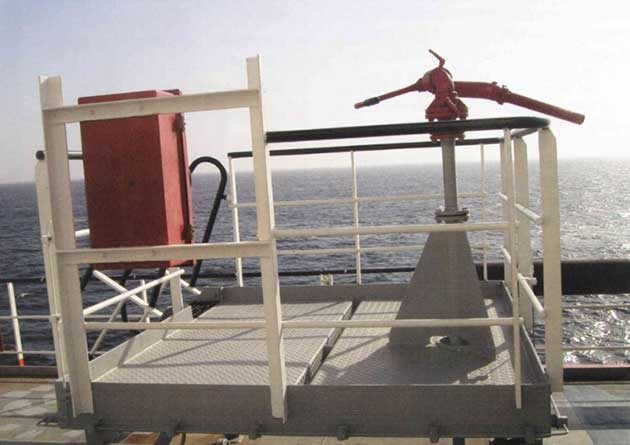
By contrast, a high expanding foam, designed to produce a thicker lighter blanket, controls the vapourisation effect by forcing the vapours to percolate through the layer of ice formed above the liquid gas. When applied to a burning gas pool fire the high expanding foam controls the fire and reduces the heat by as much as 50 %. Caution should be exercised as Hi-Ex foams are prone to wind movement and are only suitable in enclosed spaces, such as a compressor house.
LNG fires give out 3 times the heat of an oil fire of the same size.
To extinguish a liquid gas fire, dry chemical powder is needed. It is important that all fire equipment is in good order. Testing of the equipment at regular intervals is essential if a leak or fire is to be dealt with competently.
Emergency Procedures
An emergency is often the result of a breakdown of the normal operating procedures. It could also be the result of collision or grounding, a severe electrical storm, bad weather or a deliberate but mistsaken act. An emergency can occur at any time and in any situation. Emergency procedures drills should be held at regular intervals as most incidents that occur are unexpected so a quick and practised response is essential.
The only fires that have been caused on LNG Carriers to date (incl. one in 2006), have all been during electrical storms, particularly when venting cargo.
The ship/jetty interface is an area where there is always potential for a major emergency, such as the result of a fire, explosion or a large scale release of hazardous materials. When cargo is operated the ship becomes an integral part of the terminal operation. It is during this time that the greatest risk arises.
The objective of an Emergency Plan is to make maximum use of the resources of the ship and shore services, where appropriate.
These include the ability to:
- Effect the rescue and treatment of casualties;
- Safeguard other people;
- Minimise damage to property and the environment;
- Contain and bring the incident under control.
Ship’s Emergency Preparedness
The emergency procedures to be followed on gas tankers are clearly outlined in the International Chamber of Shipping Tanker Safety Guide (Liquefied Gas). The Guide urges that standard emergency procedures should be developed for each ship, and that personnel should be properly trained and drilled in them. When pre-planning an emergency organisation, four units are recommended:
- Command centre;
- Emergency party;
- Back-up emergency party;
- Engineers group.
Preliminary action includes raising the general alarm and mustering. Detailed procedures are given for specific situations such as:
- Fire;
- Collision;
- Grounding.
- Water leakage into hold or inter barrier space;
- Hose burst, pipe fracture or cargo spillage;
- Tank leakage;
- Emergency discharge of cargo at sea;
- Accidents involving personnel.
Each ship should develop its own emergency procedures, based on those proposed in the Guide. However, a standard set of emergency procedures is useful as personnel do not always serve on the same gas carrier and a uniform approach will bring advantages.
Emergency Shutdown System (ESDS)
If an incident occurs during loading or discharging operations the duty officer’s first action must be to stop cargo handling operations using the “Emergency Shut-Down System” (ESDS).

In the event of fire, gas carriers require remote-operated Emergency Shut-Down (ESD) valves to close automatically by means of a fusible plug, closing liquid and vapour valves to prevent outflows of liquid and vapour and isolating the ship from the shore in the case of an emergency.
ESD1 = ship and shore activated. ESD2 = shore activated.
Valves must be of the fail-close (close on loss of power) type. ESD valves must operate from fully open to fully closed, under all service conditions, in a minimum time consistent with the avoidance of excessive pressure surges in the attached piping, on the ship and in the shore loading system. The valves arc required to close within 30 seconds.
Emergency Disconnection of Hard Arms
Some hard arms allow for the possibility of the remote-controlled release of the hard arm from the ship in such a way as to prevent spillage of cargo. This permits loading and discharging activities to be stopped under emergency conditions from either ship-or shore-side. At the end of the loading arm, two hydraulically-operated ball valves are placed in series. A Quick Connection Disconnection (QCDC) release coupling (also hydraulically-operated) is installed.
The releasing procedure is completed as follows:
- When the emergency release switch is activated, the motor and pump of the hydraulically operated loading arm starts to run. Hydraulic cylinders for the movement of the hard arm are pressurised, avoiding the freewheeling action of the loading arm;
- Both valves at the end of the hard arm are closed simultaneously, by a single hydraulic cylinder and level system;
- At the end of the stroke, a limit switch activates the hydraulic cylinder of the quick release coupling between the two valves through which the coupling is opened;
- The hard arm is then released and raised until it clears the deck.
The closed outer valve of the hard arm remains on board the ship, connected to the manifold, while the loading arm itself is closed by the remaining valve.
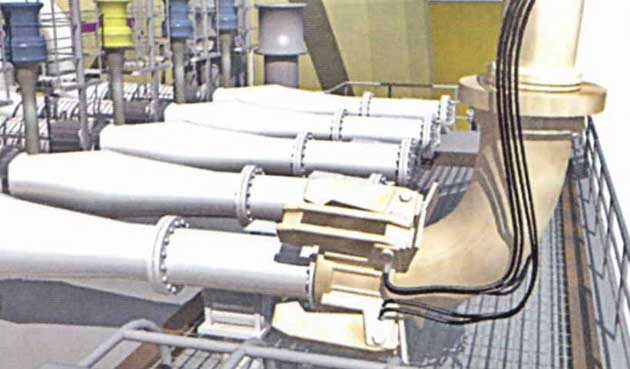
Important safeguards are necessary to avoid premature activation of the emergency release switch. The emergency stop system must be in operation and this means that the valve on the shore-side must be closed and the loading pump stopped. Because of the position of the valve on the shore-side, the ship’s pumps must also be stopped in the case of the ship discharging to shore. The loading arm can only be released when the liquid flow in the arm has been stopped.
It can take 4 hours to reconnect a hard arm after activation of the QCDC.
A second important safeguard ensures that only loading arms connected to the ship can be released. This avoids hard arms that are not in use having their QCDC’s initiated.
Emergency situations that may require the use of the emergency release system are:
- If the ship were to drift out of the working envelope of the hard arm;
- If the hard arm must be released from the manifold when the manifold position cannot be reached, for example in the case of fire or when operators are not present.
Emergency Procedures and External Resources
Should the use of the Emergency Shut-Down fail to bring the emergency under control, then the following procedures would be followed:
- Raise fire alarm;
- Start water spray system on the front of the accommodation;
- Start water spray over the tank area.
If an emergency arises within confined waters or while the ship is working cargo alongside the jetty, the deployment of outside resources to assist with the emergency effectively may be required.
The resources may include:
- Fire, police and medical emergency services;
- Port authority;
- Labour inspectorate;
- Local authority;
- Coast Guard.
The port authority will have developed an emergency plan that clearly sets out the agreed action to be taken by each agency. Each agency is then responsible for issuing its own detailed instructions within the general provisions of this plan.
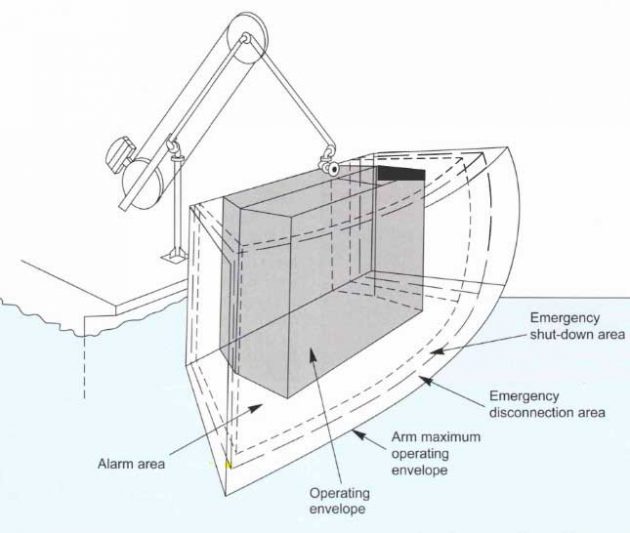
The port authority is responsible for placing a copy of the “Notice to Masters of Vessels” on board all ships at anchor, moored to buoys or underway within their area of jurisdiction. This notice sets out the frequencies to be used for communications and the methods of obtaining assistance in the event of other emergencies.
Raising the Alarm and Control of Operations
When an emergency occurs, it is vital that the alarm should be raised quickly. The jetty operator and OOW should understand and accept responsibility for initiating immediate action. All reasonable steps should be taken by those present to render assistance quickly and a rapid response to the situation is essential. At some terminals, when the emergency button is pressed, cargo handling operations will be stopped and the alarm will be simultaneously raised.
Within a port, the decision to designate an emergency and implement the emergency plan for the area is normally made by the Harbour Master. In some areas, this decision rests with the Fire Master, together with the ship’s Master.
Most area emergency plans incorporate a schematic diagram that illustrates the communications arrangements to apply in the event of an emergency. Use may be made of portable VHFs and radio telephone sets, particularly by the Chief Fire Master, Harbour Master and between the ship and jetty.
Control of Ship Movements
The decision to close the port or restrict ship movements rests with the Harbour Master. Ships should not normally move off the jetty without the agreement of the Harbour Master unless the vessel is in immediate danger or is itself presenting a risk to the jetty or terminal. Ship/shore communication can be of critical importance in this sort of situation.
Loading and Discharging
When an alarm sounds, all loading and/or discharging should stop immediately and hoses and/or hard arms should be disconnected. Loading and/or discharging should not resume without the joint agreement of both the ship’s Master and the Harbour Master or other named person designated in the emergency plan.
Fire-Fighting Operations
The initial fire-fighting response should be undertaken by personnel on the scene, with whatever equipment is available. This would be under the direction of the Master or jetty personnel until the arrival of the fire brigade, when responsibility would be assumed by the Senior Fire Officer. Strict attention must be paid to the stability of the vessel.
At some terminals, the emergency plan demands that the ship leave the jetty as soon as possible. At others, the ship is kept alongside the jetty until the emergency is brought under control. Considerations that influence this decision are usually related to the proximity of ship-to-shore tankage, availability of fire-fighting facilities on the jetty and the ease of access to and from the jetty by the ship. If sophisticated fire-fighting facilities are available, the policy at the terminal will be to detain the ship alongside to bring the emergency under control.
Emergency Situations
The types of incidents an emergency plan should cover include:
- Explosion;
- Fire;
- Escape of toxic and/or flammable gases;
- Escape of toxic and/or flammable liquids.
These incidents could be caused by:
- Rupture or leak from hard arm or cargo hose;
- Spillage;
- Overfilling of cargo tanks;
- Opening of an emergency pressure relief valve;
- Fire in the compressor or motor room;
- Fire on deck;
- Fire in the accommodation;
- Tank leakage/loss of containment.
Emergency Shut-down
Most jetties offer Emergency Shut-Down (ESD) facilities. This button, which should be clearly marked, is usually situated on the jetty but it is a recommended procedure to have the remote control placed on board the ship by umbilical. When operated, it will immediately shut off the shore cargo pumps when the ship is loading.
Normally, the rate of closure of the valves (30 secs) is timed to avoid any pressure surge in lines, which may result in cargo line fracture. Manifold valves should be closed immediately after pumps have been stopped.
Specific Emergency Plans (Ship alongside Jetty)
A general emergency plan is one that is standardised for any emergency situation.
Examples of plans that are specific include:
- Fire or explosion on the jetty;
- Fire or explosion on the ship when alongside the jetty;
- Fire or explosion on ship at anchor;
- Escape of toxic or flammable vapour;
- Cargo spillage.
The specific plans normally detail:
- Responsibility for raising the alarm;
- Method of raising the alarm;
- Action by jetty personnel;
- Action by ship’s personnel;
- Action by port authority;
- Action by fire brigade;
- Action by tugs;
- Action by medical services;
- Action by police.
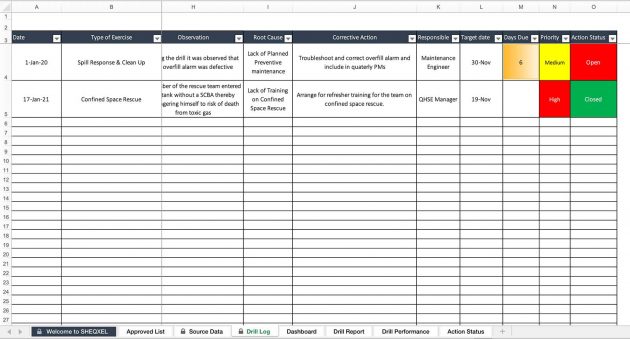
All ship and terminal emergency plans should be tested, through drills and practice, at regular intervals to check their efficiency. After each exercise the plan should be reviewed. It is highly desirable to include ships in these exercises to highlight any loopholes or inadequacies in the plan.
Emergency Procedures on Gas Carriers
In the event of any emergencies arising, the officer on watch who is on duty must:
- Activate the emergency shut-down system to stop cargo transfer;
- Raise the fire alarm;
- Call fire-fighting teams to action stations;
- Advise the terminal (by agreed signal);
- Have emergency teams prepare breathing apparatus and protective clothing for immediate action.
Examples of Emergency Procedures
The following are general check-lists for Emergency Procedures for:
- A. Fire;
- B. Fire on deck;
- C. Hose burst, pipework fracture or cargo overflow;
- D. Tank leakage in cargo hold space;
- E. Over and under pressure in the liquid header;
- F. High pressure in the cargo tanks;
- G. Vacuum in the cargo tanks (fully refrigerated);
- H. Very high level in the cargo tank;
- I. Water leakage into hold space.
Every ship must complete check-lists that take into account its own equipment and operations.
| A. Fire | B. Fire on Deck | ||
|---|---|---|---|
| [ ] | Activate emergency shut-down system (stops all cargo equipment) | [ ] | Activate emergency shut-down system |
| [ ] | Sound the general alarm | [ ] | Activate fire alarm |
| [ ] | Start all fire pumps | [ ] | Advise terminal by agreed signal |
| [ ] | Start the deck spray pump | [ ] | Shut-down any source of fuel, close all manual valves in cargo system |
| [ ] | Advise terminal by agreed signal | [ ] | Activate water sprays |
| [ ] | Muster | [ ] | Isolate fire area by properly deploying fire-fighting teams. Cool down adjacent areas |
| [ ] | Fire-fighting teams attack fire with water spray hoses and dry powder guns if necessary | [ ] | If shore fire brigade on scene, assist as directed |
| [ ] | The source of the fire | [ ] | If required, prepare to vacate the berth according to Marine Terminal Emergency Plan |
| [ ] | If shore fire brigade on scene, assist as directed | ||
| [ ] | If required, prepare to vacate berth according to Marine Terminal Emergency Departure Plan. In the event of an extreme emergency the terminal may remotely release the ship, with tug assistance | ||
| C. Hose Burst, Pipework Fracture or Cargo Overflow | D. Tank Leakage in Cargo Hold Space | ||||
|---|---|---|---|---|---|
| LOADING | AT SEA | ||||
| [ ] | Activate emergency shut-down system | [ ] | Activate emergency shut-down system | If it is a small liquid or gas leak, the ship may be able to continue her passage. Possible pressure rise in the hold space will be vented-off. It may be required to jettison cargo overboard from the hold space | |
| [ ] | Activate fire alarm. Advise terminal by agreed signal | [ ] | Advise terminal | Jettisoning of cargo | |
| [ ] | Activate water sprays | [ ] | Close all accommodation doors; stop ventilation | [ ] | All other cargo operations stopped |
| [ ] | Close all accommodation doors and stop ventilation everywhere | [ ] | Transfer cargo in leaking tank to empty tank, or to shore | [ ] | Alarm raised |
| [ ] | No smoking | [ ] | Reduce pressure in leaking cargo tank by running reliquefaction plant | [ ] | Securite-message – broadcast on VHF Ch 16 |
| [ ] | Ensure emergency parties wear breathing apparatus and protective clothing. Appropriate fire-fighting equipment, breathing protection equipment and protective clothing to be assembled ready for use | [ ] | Circulate ballast in tank below damaged tank to prevent frost damage to ship’s steel | [ ] | All accommodation access doors shut |
| [ ] | If necessary, stop non-essential machinery in engine room. When not in use, switch fire pumps, to standby | [ ] | Pump the liquid in the hold space into an undamaged tank if possible | [ ] | Ventilation system shut-down |
| [ ] | Purge all lines with inert gas | [ ] | NO SMOCKING and electrical switches used as little as possible | ||
| [ ] | Fire-fighting equipment prepared and teams ready with SCABA | ||||
| [ ] | Prepare hold space ejectors or pump (if air driven pump – operating on inert gas) | ||||
| [ ] | Erect jettison pipe overboard | ||||
| [ ] | Purge all lines with inert gas | ||||
| [ ] | Set all lines | ||||
| [ ] | Have water spray systems ready to deflect any gas | ||||
| [ ] | Check regularly, hold and tank temperatures and pressures | ||||
| [ ] | The highest pumping rate possible should be used | ||||
| E. Over and Under Pressure in the Liquid Header | F. High Pressure in the Cargo tanks | |||
|---|---|---|---|---|
| Over pressure in the liquid header | LOADING | AT SEA | ||
| This is not normally critical as the gas header piping is usually oversized. The cargo tanks have their own independent relief valves | If loading this can be caused by: – the inadvertent closing of a valve at the ships crossover or at the terminal – the sudden stopping of the reliquefaction compressors | [ ] | Have the reliquefaction compressors stopped? | |
| Underpressure of the liquid header | [ ] | Inform the terminal immediately and stop loading or decrease the rate until the cause of the high pressure has been established | [ ] | Is the Cargo Vaporiser inadvertently working? |
| This is a more critical situation as the vacuum could introduce air into the cargo tanks. This is why the low pressure alarm initiates and ESD | DISCHARGE | [ ] | Is the cargo tank insulation damaged? | |
| During discharge high pressure in the ship’s cargo tanks can be caused by excessive gas return from the shore | [ ] | Is the relief equipment malfunctioning? | ||
| [ ] | Inform the terminal and close the vapour manifold partially to reduce the incoming gas flow | |||
| G. Vacuum in the Cargo Tanks (Fully Refrigerated) | H. Very High Level in the Cargo Tank | I. Water Leakage into Hold Space | |||
|---|---|---|---|---|---|
| DISCHARGE | LOADING | Water leaks in the hold space may damage the insulation and cause a rise in cargo pressure and temperature | |||
| At low pressure (about 10 mbar), a shut-down will trip the cargo pumps, booster pumps and the reliquefaction plant | A very high level alarm will initiate a shutdown | [ ] | If an entry to the hold space is required, confined space entry procedures to be in place | ||
| [ ] | Place all pump switches to “OFF” position | [ ] | Close the concerned filling tanks immediately | [ ] | Empty the ballast tanks adjacent to the damaged hold, so far as is possible |
| [ ] | Close all valves | [ ] | Inform the terminal | [ ] | If an entry is made to the ballast tank, confined space entry procedures to be in place |
| [ ] | Keep the terminal informed | [ ] | Close all concerned valves | [ ] | Prepare bilge well ejectors or bilge pump |
| [ ] | Check the relevant tank dome vapour valve is open | [ ] | Stop any cargo pumps in use | [ ] | Pump the water for as long as required |
| [ ] | Check the relevant tank relief valves are not leaking (this will be indicated by noise and/or frozen/frosting pipes) | [ ] | Ask the terminal to reopen the vapour connection | [ ] | Monitor the hold space pressure |
| [ ] | Check that an open spraying nozzle in the relevant tank is not causing the vacuum; if necessary close the spray inlet valve | [ ] | Open the vapour manifold | ||
| [ ] | Check the operation of the cargo vaporiser (if in use) | [ ] | Check the pressure in the gas header | ||
| [ ] | If using a VRL, check with the terminal | [ ] | Transfer excess liquid to another cargo tank. System will restore when the VHL alarm clears | ||
| [ ] | Can the shore supply vapour to the ship? | [ ] | Set lines and resume loading | ||
| LOADING | DISCHARGE | ||||
| [ ] | Check the reliquefaction plant (if the ship is handling the vapour) | If a VHL (Very High Level) alarm were to initiate at the beginning of discharge, this would indicate an open or passing valve or damaged non-return valve | |||
| [ ] | Check with the terminal (if the terminal is handling the vapour) | ||||
| [ ] | Can the shore supply vapour to the ship? | ||||
| Restoring the pressure is normally only a matter of time as boil-off is always present | |||||
